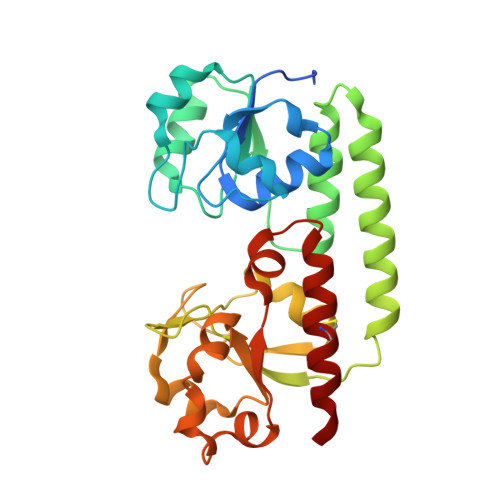Mechanistic basis of vitamin B12 and cobinamide salvaging by the Vibrio species.
Agarwal, S., Dey, S., Ghosh, B., Biswas, M., Dasgupta, J.(2019) Biochim Biophys Acta Proteins Proteom 1867: 140-151
- PubMed: 30463026
- DOI: https://doi.org/10.1016/j.bbapap.2018.11.004
- Primary Citation of Related Structures:
5YSC - PubMed Abstract:
Biosynthesis of vitamin B12, which occurs through salvaging pathway or de novo synthesis, is essential for the survival and growth of bacteria. While the mechanism is known for many bacteria, it is elusive yet for diarrhea causing pathogenic bacteria Vibrio cholerae or the other Vibrio species. Sequence analysis using genome databases delineated that majority of the Vibrio species including V. cholerae contain genes required for salvaging cobalamin/cobinamide in aerobic pathway while lack the genes required for de novo synthesis of B12. Fluorescence quenching study showed that VcBtuF, the PBP of putative ABC transporter BtuF-CD of V. cholerae O395 binds cyanocobalamin and dicyanocobinamide with micromolar dissociation constants (K d ). Productive internalization of these nutrients has been established through growth assay. The crystal structure of cyanocobalamin bound VcBtuF has shown that although interactions between cyanocobalamin and VcBtuF are largely similar to E. coli BtuF, VcBtuF possesses a wider binding pocket. MD simulations indicated that in contrast to EcBtuF that executes 'open-close' movement, inter-lobe twisting is prevalent in VcBtuF. Although H70, located at the entrance of the substrate binding cleft of VcBtuF, executes swinging motion, it cannot act as 'closed gate' to retain cyanocobalamin or cobinamide in the pocket like corresponding residue W66 of EcBtuF. Rather, VcBtuF shows a distinctive phenomenon of heme binding with comparable affinity to B12. Soret shift of heme upon binding with VcBtuF pointed towards involvement of H70 in heme recognition. This may lead to a restricted B12 or cobinamide binding during abundance of heme in the periplasmic space.
Organizational Affiliation:
Department of Biotechnology, St. Xavier's College, 30 Park Street, Kolkata 700016, India.
















